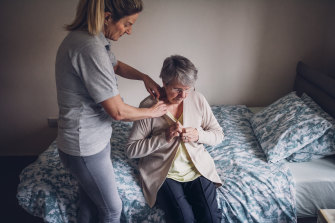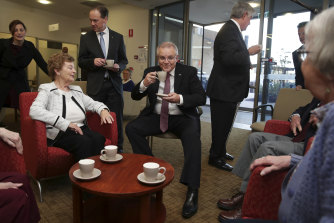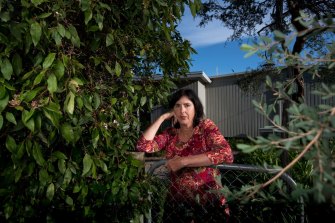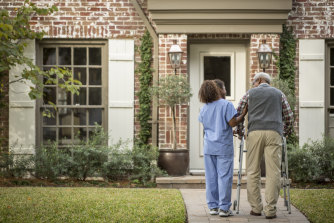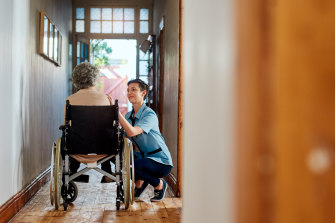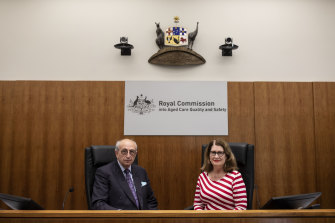What is the full extent of the problem in aged care? How does our system compare with those overseas? And what would it take for it to meet older Australians’ needs?
It’s been more than 20 years since the revelation that 56 residents of a Melbourne nursing home were bathed in kerosene sent shockwaves across the nation. The diluted kerosene – an archaic treatment for the contagious skin mite condition scabies – caused some residents to break out in blisters and rashes.
The scandal led to the closure of Riverside nursing home in Patterson Lakes in suburban Melbourne in 2000 and a national outcry over the standard of care in nursing homes, after other stories emerged of elderly people being mistreated in facilities throughout the country.
The federal government agreed to overhaul the aged care complaints system following an Ombudsman report later that year.
But despite 18 major inquiries and reviews into aged care in Australia since 1997, the sector – which provides services to about 1.3 million Australians – is still dogged by incidents of abuse and negligence.
The COVID-19 pandemic has also highlighted the vulnerability of those in aged care facilities, with 685 residents dying from the virus. Asked last year if these deaths had been “avoidable”, Health Department Secretary Brendan Murphy said the government could have prevented some of the spread of the coronavirus if it had acted earlier.
A royal commission is the latest investigation into the system. It was set up in 2018 by Prime Minister Scott Morrison, who said at the time: “If you want to deal with a problem, you have to be fair dinkum about understanding the full extent of it. Whether there is a crisis in aged care or not is to be determined.”
So what will we discover? What is the full extent of the problem in aged care – is it in crisis? How does our system compare with those overseas? What would it take for aged care to meet older Australians’ needs?
The 1997 Aged Care Act removed the requirement for nursing homes to spend a fixed proportion of their funding on direct care, including the salaries of nurses. Credit:Getty Images
Where did the current aged care system come from?
Aged care is the responsibility of the federal government, which is charged with funding, accrediting and regulating the sector.
Nursing homes, known officially as residential aged-care facilities, can be private for-profit, not-for-profit or operated by state or local governments.
For-profit homes are owned by everything from private family companies to listed entities such as Japara and Estia to large international conglomerates such as Bupa. The not-for-profits are usually run by church-based charities such as Anglicare and Uniting Care.
Prior to 1997, nursing homes were required to spend a proportion of their funding on direct care, including the salaries of nurses. However this requirement was removed under the 1997 Aged Care Act – brought in under the Howard government – which opened up the sector to privatisation.
The 1997 Act was intended to simplify funding, increase choice in care, stop residents having to move from a hostel to a nursing home when they became more frail and introduce new accreditation standards designed to improve the quality of facilities.
It led to nurses being replaced by low-skilled care workers and an increase in nursing homes being run by private for-profit providers.
“I think the Act is a massive, massive problem with driving corporatisation,” says Professor Joseph Ibrahim, the head of the Health Law and Ageing Research Unit at Monash University.
“What that did was actually remove controls that were in place that ensured a set amount of staffing and a certain amount of transparency. So aged care homes reduced staff and made money that went into their own pocket.”
Prime Minister Scott Morrison visits a Canberra retirement village with ministers Greg Hunt and Ken Wyatt in September 2018.Credit:Alex Ellinghausen
How did the current royal commission come about?
In mid-2017, the emergence of critical care failures over 10 years at Oakden nursing home in Adelaide – including mis-medication of residents, a sexual assault by a carer and a murder by a resident – fuelled claims that the aged-care sector was in crisis.
Later that year, The Age reported allegations of misconduct in Victorian aged care facilities in a troubling four-part series, Is this How it Ends?
Then, in 2018, Morrison announced a royal commission into the aged care sector on the eve of a highly anticipated ABC Four Corners investigation into abuse in nursing homes.
“Many people receiving aged care services have their basic human rights denied. Their dignity is not respected and their identity is ignored.”
“When we called the Royal Commission we made clear we need to deal with fundamental failings in the aged care sector, which have been happening not just recently but over decades,” Morrison said on Thursday.
The Royal Commission heard from 641 witnesses – the oldest of whom was 105 – over almost 100 days of hearings, received more than 10,000 submissions and produced 38 reports and research papers. Its final report on the aged care system was handed to the federal government on February 26, and was to be released publicly the following week.
But the excoriating interim report released in 2019, portentously titled Neglect , pulled no punches. “The Royal Commission has heard compelling evidence that the system designed to care for older Australians is woefully inadequate,” the foreword said.
“Many people receiving aged care services have their basic human rights denied. Their dignity is not respected and their identity is ignored. It most certainly is not a full life. It is a shocking tale of neglect.”
The interim report said older people and their families were left isolated and powerless in a “hidden-from-view system”.
“This cruel and harmful system must be changed … We owe it to future generations. Older people deserve so much more.”
Aged care advocate Sarah Russell says most of the concern is around a lack of staffing and training.Credit:Penny Stephens
So what’s actually wrong with the system?
The major quality and safety issues brought to the Royal Commission’s attention included assaults, residents left lying in urine or faeces, inadequate wound treatment, dreadful food, widespread over-prescribing of drugs to sedate residents and patchy palliative care.
“It is shameful that such a list can be produced in 21st-century Australia,” the Royal Commission’s interim report said.
An estimated 50 people in residential aged care were sexually assaulted each week, counsel assisting the inquiry Peter Rozen, QC, told the commission.
The Dietitians Association of Australia estimated that between 22 and 50 per cent of people in residential aged care were malnourished. The average amount spent on food was $6.08 per resident a day, according to a 2017 study.
Rozen told the commission at least one in five people in residential aged care have received substandard care.
At its heart, most of the concern is around the lack of staffing and training, according to Dr Sarah Russell, the co-founder of Aged Care Reform Now, a lobby group that represents the views of older people and their families.
Nursing homes have no minimum legal ratio of staff to residents and no statutory requirement to have a registered nurse – whose training is different to those of carers – on duty at all times.
About 70 per cent of aged care workers are only qualified with a Certificate III, which requires as little as six weeks’ training.
This is especially problematic given about two-thirds of residents in aged care homes are living with dementia and require specific care, supervision and intensive personal interaction.
“The aged care sector suffers from severe difficulties in recruiting and retaining staff,” the Royal Commission’s interim report said.
“Workloads are heavy. Pay and conditions are poor, signalling that working in aged care is not a valued occupation … Major change is necessary to deliver the certainty and working environment that staff need to deliver great quality care.”
“The home looks nice and there’s a glossy brochure but you don’t know that they’ve had 15 complaints about neglect or negligence or abuse.”
Senior Counsel assisting the Royal Commission, Peter Gray, said aged care providers were being “stretched beyond their limits”.
“They’re in effect being squeezed and must choose between financial viability and providing the level of care that’s the minimum standard required to support their residents – an impossible situation.”
Sean Rooney is the CEO of Leading Age Services Australia, the national peak body for age service providers. He says the majority of aged care homes are small businesses.
“You might get headlines around Maserati-driving executives making lots of money but that is not representative of the vast majority of the sector.”
The Royal Commission’s interim report also pointed to a lack of transparency in communication, reporting and accountability.
While aged care homes receive about $13.6 billion from the government every year, there is little scrutiny of how they spend it.
Russell, from Reform Aged Care Now, also points to a culture of secrecy around complaints.
“The home looks nice and there’s a glossy brochure but you don’t know that they’ve had 15 complaints about neglect or negligence or abuse.”
Most older Australians needing home care would prefer not to move in with family. Credit:Getty Images
Couldn’t older people just go and live with their families?
It’s often assumed that older people would jump at the chance to live with their children.
However, research conducted for the Royal Commission found the majority of older people wanted an ongoing relationship with their family but did not wish to live with them.
“I think there’s a sense that it’s a burden for their children and it’s also possibly a little bit restrictive for them,” says Jessica Elgood, the director of market research company Ipsos, which held 35 focus groups.
“But equally those older people see aged care settings frequently as simply being a place to go and die. Overall, people wanted to live independently.”
But Elgood says people from culturally and linguistically diverse backgrounds – who were more likely to have grown up with a grandparent living in their family home – had a stronger expectation of providing care to their parents as they aged.
A Roy Morgan poll last year also found older Australians (people aged 70 or older) had a strong preference to stay in their own home should they ever have a need for support or care.
“The level of commitment to remaining in place increases as people approach their 70s.”
Only 25 per cent stated they would prefer to live in a residential aged care facility.
There was a strong preference for paid help: only 25 per cent of older Australians said they would like assistance from their family with dressing, eating and going to the toilet.
“The level of commitment to remaining in place increases as people approach their 70s,” the research says.
Lauren Rosewarne, an associate professor in public policy, social and political sciences at Melbourne University, says there are an enormous range of reasons why living with adult children may not be possible. These include the parent having complex care needs, space constraints, inter-generational conflict, the adult children having demanding jobs, privacy concerns and the older person being keen to retain their independence.
The waiting list for at-home care packages has consistently remained at about 100,000.Credit:Getty Images
If people prefer home care, can’t that just be arranged?
Australia has a high rate of older people living in institutions, as opposed to receiving home care (more on that below).
In Australia, older people who want to stay in their homes are facing delays of up to two years and four months before they can access government support for tasks such as cleaning and showering.
The waiting list for at-home care packages has consistently remained at about 100,000.
More than 14,000 people who had been approved for the highest level of funding had a median wait of 28 months, according to the Productivity Commission. Many die waiting.
In the three years to mid-2020, about 30,000 people died while waiting for services, a Senate inquiry heard last year.
The government has invested $5.5 billion in new funding to deliver 83,105 home care packages since the 2018-19 budget, according to a spokesperson for Aged Care Minister Greg Hunt.
“The government is also delivering record investment across the entire aged care system from $13.3 billion in 2012-13, to $24, $25, $26 and $27 billion over this year and the coming three years.”
The spokesperson says the government responded to the Royal Commission’s interim report with a focus on more home care packages, reducing the number of young people living in residential aged care and improving medication management.
Australia’s spending on long-term aged care is among the lowest of comparable OECD countries. Credit:Getty Images
Do other countries have better aged care systems?
Flinders University researchers compared Australia’s aged care system with 13 comparable OECD countries. They found Australia’s spending on long-term care was among the lowest – around 1.2 per cent of its gross domestic product, compared to more than 4 per cent in Denmark and Sweden.
Australia also had a high proportion of older people living in aged care homes as opposed to receiving care in the home. Of Australians aged over 65 who received long-term care, 52.5 per cent were in an institution, compared with 21.6 per cent in Japan and 34.6 per cent in the Netherlands.
“It is likely that we have one of the longest waiting lists amongst OECD countries at the moment for home care packages.”
This is concerning when you consider the Roy Morgan poll found the majority of older Australians wanted to remain in their home when receiving care.
Julie Ratcliffe, a professor of health economics at Flinders University, says the waiting list for home care packages is undoubtedly shifting Australians into residential care sooner.
“Comparable international data is hard to come by but it is likely that we have one of the longest waiting lists amongst OECD countries at the moment for home care packages,” Ratcliffe says.
“People are transitioning into residential care much more quickly because they’re not getting the care and support that they need in their own homes, at the right levels, at the right time.”
Professor Joseph Ibrahim: “We block off any thought about getting old.”Credit:Jason South
How did things get this dire?
Firstly, none of us want to think about getting old.
“We don’t sit down and say, ‘imagine a future where I have arthritis and have pain whenever I move. I wonder what that’s like?’,” says Professor Joseph Ibrahim, head of the Health Law and Ageing Research Unit at Monash University.
“What we do is we block off any thought about getting old, about disability and about death. And so none of us really think about how tough it could be and what would actually make it easier.”
During 2020’s byelection in the bellwether federal electorate of Eden-Monaro, Catholic Health Australia polled nearly 700 voters. Eighty four per cent believed “the aged care system is in crisis”.
“We then asked these same voters to consider seven issues and rank them in terms of importance,” Catholic Health Australia CEO Pat Garcia writes.
“Less than 4 per cent of respondents raised aged care as an issue driving their vote.”
“Aged care came a dismal last. Less than 4 per cent of respondents raised aged care as an issue driving their vote.”
When you really boil it down, Garcia writes, no election has ever turned on aged care.
“All of us know aged care is in crisis. The problem is we don’t really care.”
This could also help explain why, as a paper produced for the royal commission says, “successive Australian governments have shown a lack of willingness to commit to change or to adopt recommendations from a multitude of reviews and inquiries”.
Ibrahim puts it like this: “If you say you have a million dollars to spend, will you spend it on a bunch of 90-year-olds to make their last year of life happier or would you spend it on anyone else that’s younger? Almost no one will spend money on a 90-year-old to make their life happier.”
Royal commissioners Tony Pagone and Lynelle Briggs.
How can we fix it?
Lawyers assisting the Royal Commission made 124 recommendations. These include a new independent watchdog, a new aged care act based on human rights principles, mandated staffing ratios, extra nurses, specialised aged care GPs and compulsory registration for aged care workers.
They call for the home care package waiting list to be cleared by the end of this year and an assurance new recipients don’t wait longer than a month.
Counsel recommend a star rating for aged care homes to help older people and their families choose the best facility. They also say funding should be based on need and not rationed. The current system is capped, which means the government only supports a certain number of people in home care and residential care at a given time.
But just how contentious some of the recommendations might be was telegraphed in the final hearings when the two royal commissioners, Lynelle Briggs and Tony Pagone, expressed conflicting views on one key area of reform.
Briggs questioned the establishment of a new commission which would regulate aged care and be independent of government, asking how any benefits “would outweigh the very substantial costs and disruption involved”.
But Pagone appeared in favour of the proposal and emphasised Briggs’ remarks “are not intended to be a final decision by us”.
“My hope for the future of aged care in Australia is to provide quality holistic, person-centred care by suitably trained staff.”
Nell Hawe, who is living with dementia, said: “My hope for the future of aged care in Australia is to provide quality holistic, person-centred care by suitably trained staff to those people living with dementia and others using aged care, and their carers and families.”
Meanwhile, the Grattan Institute has suggested that an extra $7 billion a year – a 35 per cent increase on current spending – could provide Australians with the care they need.
Under its proposed reforms, older Australians would have universal access to aged care in the same way they do to health care via Medicare.
Residents of aged care homes would contribute to their accommodation costs by paying rent but a means test would be applied, with some paying less rent and some none at all.
The Grattan model would see more older Australians receiving care in their own homes, 24-hour nursing supervision in aged care facilities and minimum resident-to-carer ratios.
So will the aged care system now finally be overhauled?
The royal commission has said it will recommend major transformation of the aged care system in Australia.
Aged Care Minister Greg Hunt, who receives the report on February 26, said he was anticipating it could be well over 1000 pages and there could be more than 100 recommendations.
“We will release the report and provide an interim response by the middle of next week, and we will provide a full response during the course of the budget because it will actually be a major initiative, as the Prime Minister and the Treasurer have previously indicated,” Hunt said.
Rooney, the CEO of Leading Age Services Australia, says: “This is the one chance we’re going to get to deal with years, if not decades, of Band-Aid solutions. This is an issue for the nation. It’s not about politics, it’s about doing what’s right.”
“This is the one chance we’re going to get to deal with years, if not decades, of Band-Aid solutions. This is an issue for the nation.”
But the big question is how will we pay for it all?
Deloitte modelling commissioned by the royal commission said a one- percentage-point increase in income tax rates or lifting the Medicare levy by 0.89 per cent would be enough to fund a good-quality system.
Separate Flinders University research found 61 per cent of taxpayers surveyed would be willing to pay 3.1 per cent more tax on average to ensure all Australians had access to high-quality aged care.
But Morrison last year appeared to rule out a tax hike.
“I will await [the Royal Commission’s] recommendations but the Australian Government, particularly in the middle of a pandemic … the one way you build your economy back is you don’t hit it with higher taxes,” he said in September.
“And that is not our plan, it has never been our plan. Our plan to grow our economy has always been about getting people’s backs, not getting on them.”
Ratcliffe, the author of the Flinders University research, is concerned any reform of aged care will not “go anywhere near far enough”.
“Honestly, I’m not that optimistic,” she says. “And the main issue is funding, I think that’s at the heart of it. I don’t know whether there’s the appetite to deliver on it, given all the priorities at the moment.”
If you'd like some expert background on an issue or a news event, drop us a line at [email protected] or [email protected]. Read more explainers here.
Most Viewed in Politics
Source: Read Full Article

